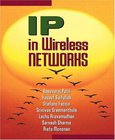Adaptation and Cross Layer Design in Wireless Networks

Book Details:
| Publisher: | CRC Press |
| Series: | CRC Press |
| Author: | Mohamed Ibnkahla |
| Edition: | 1 |
| ISBN-10: | 1420046039 |
| ISBN-13: | 9781420046038 |
| Pages: | 528 |
| Published: | Aug 19 2008 |
| Posted: | Nov 19 2014 |
| Language: | English |
| Book format: | |
| Book size: | 16.23 MB |
Book Description:
Adaptive techniques play a key role in modern wireless communication systems. The concept of adaptation is emphasized in the Adaptation in Wireless Communications Series through a unified framework across all layers of the wireless protocol stack ranging from the physical layer to the application layer, and from cellular systems to next-generation wireless networks. Adaptation and Cross Layer Design in Wireless Networks is devoted to adaptation in the data link layer, network layer, and application layer. The book presents state-of-the-art adaptation techniques and methodologies, including cross-layer adaptation, joint signal processing, coding and networking, selfishness in mobile ad hoc networks, cooperative and opportunistic protocols, adaptation techniques for multimedia support, self organizing routing, and tunable security services. It presents several new theoretical paradigms and analytical findings which are supported with various simulation and experimental results. Adaptation in wireless communications is needed in order to achieve high capacity and ubiquitous communications. The current trend in wireless communication systems is to make adaptation dependent upon the state of the relevant parameters in all layers of the system. Focusing on simplified cross layer design approaches, this volume describes advanced techniques such as adaptive resource management, adaptive modulation and coding, 4G communications, QoS, diversity combining, and energy and mobility aware MAC protocols. The first volume in the series, Adaptive Signal Processing in Wireless Communications (cat no.46012) covers adaptive signal processing at the physical layer.
Download Link:
Related Books:
Physical Layer Security in Wireless Communications
Physical layer security has recently become an emerging technique to complement and significantly improve the communication security of wireless networks. Compared to cryptographic approaches, physical layer security is a fundamentally different paradigm where secrecy is achieved by exploiting the physical layer properties of the communication system, such as thermal noise, interference, and the time-varying nature of fading channels.Written by pioneering researchers, Physical Layer Security in Wireless Communications supplies a systematic overview of the basic concepts, recent advancements, and open issues in providing communication security at the physical layer. It introduces the key concepts, design issues, and solutions to physical layer securit...
Spectrum Sharing in Wireless Networks
Fairness, Efficiency and Security
Spectrum Sharing in Wireless Networks: Fairness, Efficiency, and Security provides a broad overview of wireless network spectrum sharing in seven distinct sections: The first section examines the big picture and basic principles, explaining the concepts of spectrum sharing, hardware/software function requirements for efficient sharing, and future trends of sharing strategies. The second section contains more than 10 chapters that discuss differing approaches to efficient spectrum sharing. The authors introduce a new coexistence and sharing scheme for multi-hop networks, describe the space-time sharing concept, introduce LTE-U, and examine sharing in broadcast and unicast environments. They then talk about different cooperation strategies to achieve m...
IP in Wireless Networks
IP in Wireless Networks is the first network professional's guide to integrating IP in 2G, 2.5G, and 3G wireless networks. It delivers systematic, expert implementation guidance for every leading wireless network, including 802.11, Bluetooth, GSM/GPRS, W-CDMA, cdma2000, and i-mode. In-depth coverage encompasses architecture, technical challenges, deployment and operation strategies, mobility models, routing, and applications. The book presents future evolution of the Wireless IP Networks with emerging applications and the role of standardization bodies....
2007 - 2021 © eBooks-IT.org



